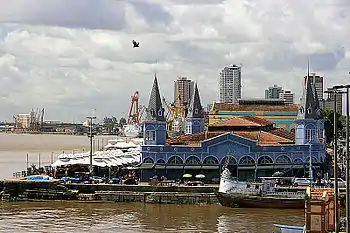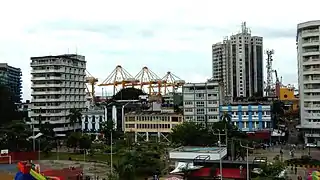City of Gastronomy
UNESCO's City of Gastronomy project is part of the wider Creative Cities Network. The Network was launched in 2004, and organizes member cities into seven creative fields: Crafts and Folk Art, Design, Film, Gastronomy, Literature, Media Arts, and Music.[1]

Criteria for Cities of Gastronomy
To be approved as a City of Gastronomy, cities need to meet a number of criteria set by UNESCO:[2]
- Well-developed gastronomy that is characteristic of the urban centre and/or region;
- Vibrant gastronomy community with numerous traditional restaurants and/or chefs;
- Endogenous ingredients used in traditional cooking;
- Local know-how, traditional culinary practices and methods of cooking that have survived industrial/technological advancement;
- Traditional food markets and traditional food industry;
- Tradition of hosting gastronomic festivals, awards, contests and other broadly-targeted means of recognition;
- Respect for the environment and promotion of sustainable local products;
- Nurturing of public appreciation, promotion of nutrition in educational institutions and inclusion of biodiversity conservation programmes in cooking schools curricula.
Cities submit bids to UNESCO to be designated. The designations are monitored and reviewed every four years.
About the cities

The first City of Gastronomy was Popayán in Colombia, designated in 2005. It hosts an annual National Gastronomic Congress of Popayán.[3]
Chengdu is the capital of Sichuan and Sichuanese cuisine, one of the most popular types of cuisine in China. The city is the birthplace of numerous dishes and snacks, including Mapo doufu and Dan Dan Noodles, and has a distinct and vibrant tea house culture.
Bergen is a port city with a long history in seafood trade. Local gastronomy thrives on organic food. Bergen hosts the world’s largest conference on seafood, the North Atlantic Seafood Forum Conference, and is also home to the Centre of Expertise for Sustainable Seafood and the National Institute of Nutrition and Seafood Research.[4]
Rasht represents Iranian cookery. The dominant foods are various types of fish. The region is famous for several distinctive dishes as well as the typical cooking method in Gamaj clay pots.[5][6]
Tucson has been selected because of "region's rich agricultural heritage, thriving food traditions, and culinary distinctiveness".[7] Tucson is well known for its Sonoran-style Mexican food.[8][9]
Alba is famous for its white truffles and vineyards. The city is referred to as the White Truffle Capital and holds an annual Truffle Festival. Alba also played the key role in the creation and development of the Slow Food movement.[10]
Macau represents a unique blend of Cantonese and Portuguese influence in culinary arts. An example is African chicken, a dish which includes Asian ingredients next to peri-peri peppers brought from Mozambique by Portuguese explorers. The city holds Macao Food Festival and other food-related events.
65% of the territory of Belém is situated across 39 islands - this feature provides diversity of local food products such as seafood, açaí, cocoa and pupunha. The city has a famous historic food market, Ver-o-Peso, where food-related events are held.[11]
Bendigo
Cities of Gastronomy
There are thirty-six Cities of Gastronomy. Eight countries have more than one designated city. Brazil has as many as four and China has four if Macao is included. Turkey and Italy both have three Cities of Gastronomy, while Colombia, Mexico, Spain and United States have all two entries on the list.
The Cities of Gastronomy are:
| City | Country | Date of inscription |
|---|---|---|
| Afyonkarahisar | 2019[12] | |
| Alba | 2017 | |
| Arequipa | 2019[12] | |
| Belém | 2015 | |
| Belo Horizonte | 2019[12] | |
| Bendigo | 2019[12] | |
| Bergamo | 2019[12] | |
| Bergen | 2015 | |
| Buenaventura | 2017 | |
| Burgos | 2015 | |
| Chengdu | 2010 | |
| Cochabamba | 2017 | |
| Dénia | 2015 | |
| Ensenada | 2015 | |
| Florianópolis | 2014 | |
| Gaziantep | 2015 | |
| Hatay Province | 2015 | |
| Hyderabad | 2019[12] | |
| Jeonju | 2012 | |
| Macao | 2017 | |
| Mérida | 2019[12] | |
| Overstrand Hermanus | 2019[12] | |
| Portoviejo | 2019[12] | |
| Östersund | 2010 | |
| Panama City | 2017 | |
| Paraty | 2017 | |
| Parma | 2015 | |
| Phuket | 2015 | |
| Popayán | 2005 | |
| Rasht | 2015 | |
| San Antonio | 2015 | |
| Shunde | 2014 | |
| Tsuruoka | 2014 | |
| Tucson | 2015 | |
| Yangzhou | 2019[12] | |
| Zahlé | 2013 | |
References
- "Creative Cities Network".
- "The Creative Cities Network" (PDF). Retrieved 2019-12-07.
- "Visit Colombia". Retrieved 7 December 2019.
- "Bergen. About the Creative City". Retrieved 7 December 2019.
- "Rasht. About the Creative City". Retrieved 7 December 2019.
- "Food in Rasht, Creative City of Gastronomy". Retrieved 7 December 2019.
- "Visit Tucson". Retrieved 7 December 2019.
- Alpers, Jackie. "Welcome to Tucson: 10 Must-Try Mexican-Inspired Dishes" Archived April 15, 2016, at the Wayback Machine, Food Network. Retrieved April 10, 2016.
- Arellano, Gustavo (March 6, 2018). "Why Doesn't Tucson's Mexican Food Scene Get More National Attention?" Archived March 28, 2018, at the Wayback Machine WAMU. Retrieved March 28, 2018.
- "Alba. About the Creative City". Retrieved 7 December 2019.
- "Belém. About the Creative City". Retrieved 7 December 2019.
- "UNESCO designates 66 new Creative Cities". 30 October 2019. Retrieved 7 December 2019.
External links
- Creative Cities Map, UNESCO.

